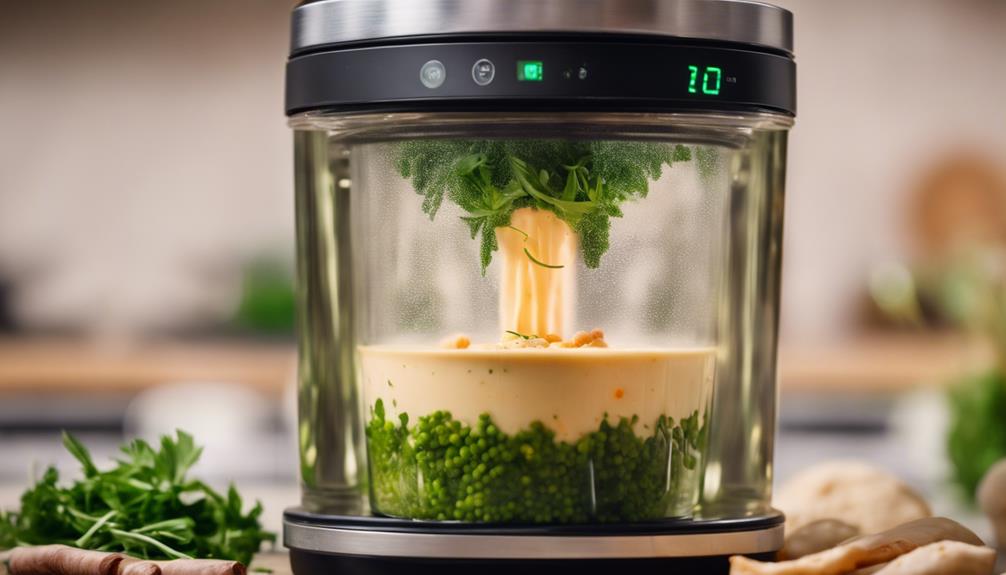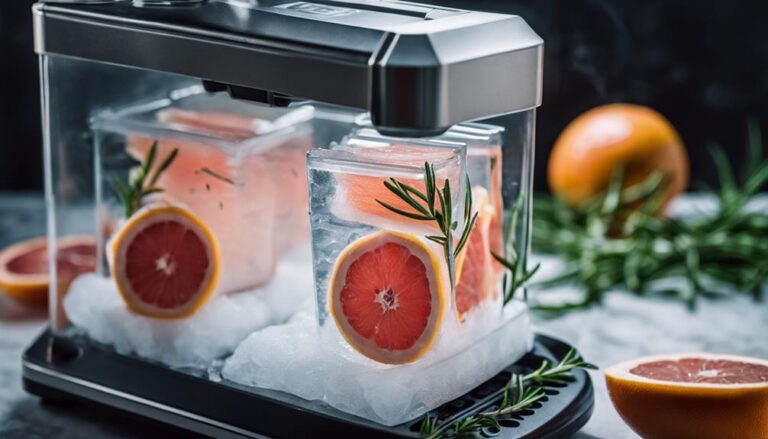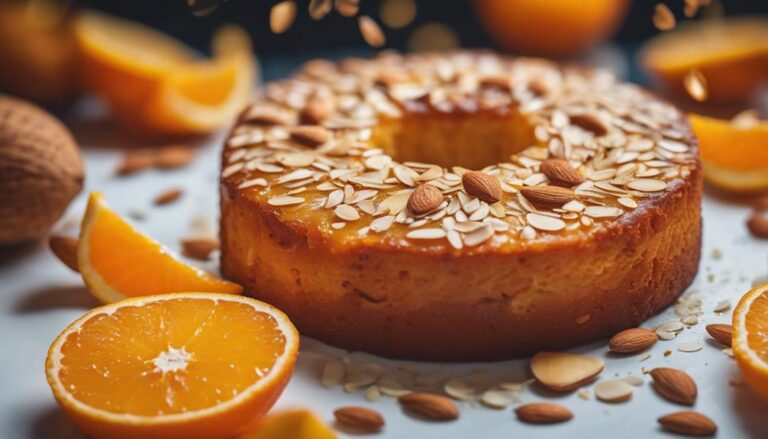Sous Vide Hummus: Creamy and Flavorful
For creamy and flavorful hummus, sous vide cooking is crucial. Sous vide guarantees chickpeas are perfectly cooked, leading to a consistently smooth texture. This method intensifies flavors, enhancing the overall taste profile. Achieve a velvety consistency by blending ingredients precisely. Sous vide maintains essential consistency and evenly cooks the beans. Vacuum-sealing boosts flavor complexity effortlessly. Explore how sous vide enhances hummus silkiness and delivers robust taste with minimal effort.
What You Will Learn Here
- Sous vide ensures perfectly cooked chickpeas for a creamy texture.
- Precise temperature control intensifies flavors for a robust taste profile.
- Vacuum-sealing enhances hummus taste complexity.
- Consistent results with velvety smooth hummus every time.
- Nutrient retention and flavor enhancement with sous vide cooking.
Origin of Hummus
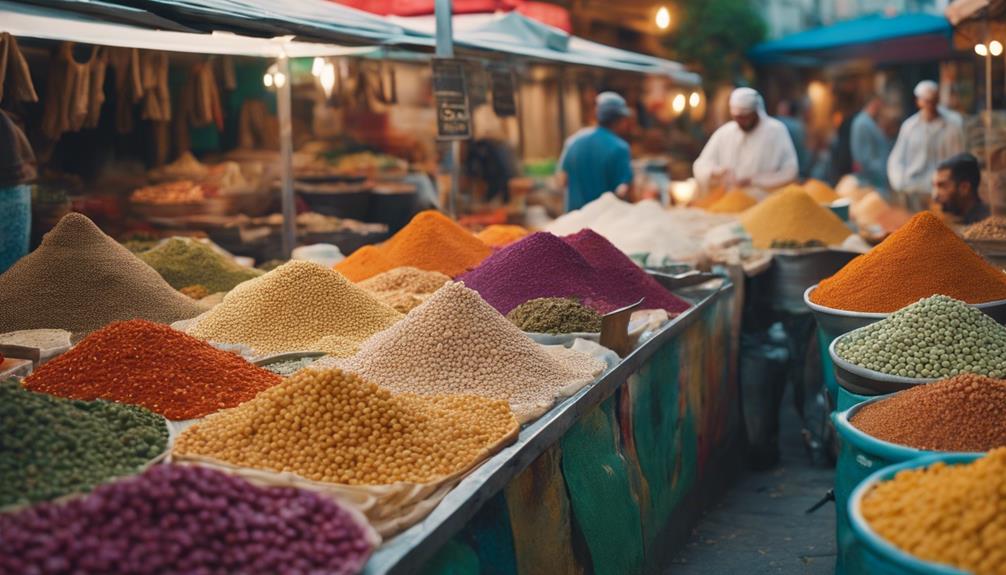
Hummus originated in the Middle East, with the earliest known recipe dating back to 13th-century Egypt.
The traditional blend of chickpeas, tahini, lemon juice, garlic, and olive oil gives hummus its distinctive flavor profile.
This nutritious and flavorful dip has transcended its origins and is now enjoyed worldwide.
Hummus Historical Roots
With ancient roots traced back to Egypt and Mesopotamia, the historical origins of hummus can be found in early cookbooks from the 13th century. The earliest recipes for hummus consisted of cooked chickpeas, lemon juice, olive oil, and garlic, showcasing the simplicity and robust flavors that define this dish.
The use of olive oil added a rich texture and depth to the hummus, while the lemon juice provided a tangy brightness that complemented the earthy chickpeas. These foundational ingredients formed the basis of hummus as it's recognized today, with regional variations and adaptations shaping its evolution over the centuries.
The historical ties of hummus to the Levant region underscore its cultural significance and enduring popularity as a beloved culinary icon.
Hummus Middle Eastern
Emerging from the culinary traditions of the Middle East, the origins of hummus remain a subject of debate among countries in the region. Historical records indicate that hummus has been enjoyed in the Middle East for centuries, with variations in recipes and techniques.
One key ingredient that has been a point of contention in the preparation of hummus is baking soda. Baking soda is often used in the cooking process to help soften the chickpeas during boiling, resulting in a smoother texture for the final dish.
While the exact birthplace of hummus is still disputed, the use of baking soda in its preparation is a common thread among different regional variations, showcasing the intricate details involved in perfecting this beloved Middle Eastern dish.
Hummus Popular Worldwide
Originating from the culinary traditions of the Middle East, the global popularity of this savory chickpea-based dish has soared in recent years.
Hummus, with its roots in countries like Lebanon, Israel, and Palestine, has become a staple in many households worldwide. Its widespread appeal can be attributed to not only its delicious taste but also its numerous health benefits. Packed with protein, fiber, and essential nutrients, hummus is a nutritious choice for a snack or meal.
Additionally, its versatility allows for a wide range of flavor variations, from classic garlic and lemon to roasted red pepper or spicy jalapeño. This adaptability has contributed to hummus becoming a beloved option for health-conscious individuals and food enthusiasts globally.
Chickpeas and Tahini
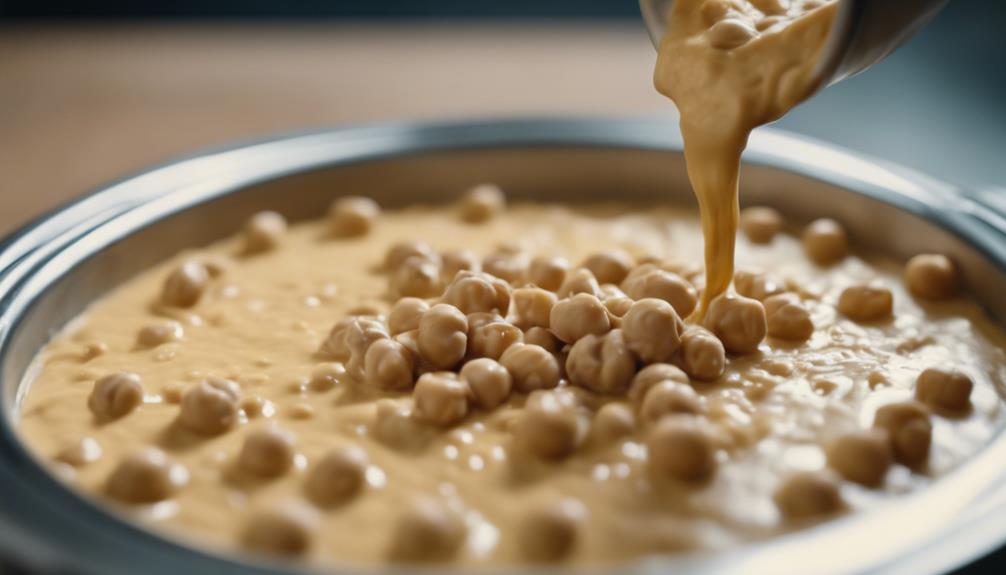
Chickpeas and tahini form the foundational base of a delectable hummus recipe, showcasing their versatility and importance in achieving a creamy and flavorful outcome. When considering chickpeas and tahini for your hummus, here are some critical points to keep in mind:
- Chickpea Varieties: Different chickpea varieties can subtly alter the texture and flavor of your hummus. Experiment with options like Kabuli and Desi chickpeas to find your preferred taste profile.
- Tahini Quality: Opt for high-quality tahini to enhance your hummus. Look for tahini made from well-sourced sesame seeds and processed carefully to guarantee a rich, nutty flavor profile.
- Homemade vs. Store Bought: Making your own hummus allows you to control the ingredients and customize the flavor to your liking. Homemade hummus, especially when using quality tahini, often surpasses the taste of store-bought versions.
Delicious Hummus Variations
You can explore a variety of delicious hummus variations by incorporating unique ingredients like roasted beetroots or pumpkin spice for a creative twist on this classic dish.
Enhancing the flavor profile with additions such as feta cheese or seasonal spices can elevate the taste experience of your hummus.
Trying out different combinations like creamy beetroot hummus, beet and feta hummus, or pumpkin spice hummus can introduce exciting new flavors to your culinary repertoire.
Creamy Beetroot Hummus Recipe
Blending beetroot with chickpeas in this recipe creates a visually appealing and creamy hummus that offers a unique twist on the traditional dish. Roasted beetroot enhances the vibrant color and earthy flavor profile of the hummus, while the citrus tahini adds an invigorating zing that complements the sweetness of the beetroot.
The garlic infusion provides a subtle yet distinctive savory note that balances the overall flavor profile. This creamy beetroot hummus combines chickpeas, tahini, lemon juice, garlic, and beetroot to create a nutritious and delicious alternative to classic hummus variations.
The combination of ingredients results in a smooth and luscious texture that's sure to tantalize your taste buds.
Beet and Feta Hummus
Incorporating beets and feta cheese into traditional hummus results in a vibrant and flavorful variation that offers a unique blend of earthy sweetness and creamy tanginess. This colorful hummus variation not only provides a visually appealing twist on the classic recipe but also brings a delightful array of flavors to the table.
- Creamy Texture: The addition of feta cheese enhances the hummus's creaminess, creating a smooth and velvety texture.
- Nutritional Benefits: Beet and feta hummus is packed with nutrients and antioxidants from the beets, offering a healthy and flavorful snack option.
- Flavorful Combinations: The earthy sweetness of beets combined with the tanginess of feta cheese creates a harmonious flavor profile that's both satisfying and unique.
Pumpkin Spice Hummus Recipe
The introduction of pumpkin spice hummus offers a delightful fusion of savory and sweet notes, elevating the traditional hummus recipe with a seasonal twist. This festive flavor profile is perfect for autumn gatherings or holiday parties. The recipe typically includes pumpkin puree, chickpeas, tahini, maple syrup, and pumpkin pie spice. Here are some key points about this sweet and savory hummus variation:
- Incorporates warming spices like cinnamon, nutmeg, and cloves.
- Provides a creamy and aromatic texture.
- Can be enjoyed as a spread on toast, crackers, or as a dip for fruits and vegetables.
Try this unique pumpkin spice hummus for a delicious twist on a classic favorite.
Hummus Texture Enhancement
To enhance the texture of your hummus, consider focusing on achieving a smooth consistency by precisely cooking the beans with sous vide.
The creamy silkiness of hummus can be optimized by utilizing tips that guarantee a consistent and well-balanced blend of ingredients.
Enhancing the overall creaminess of your hummus involves attention to detail and technique to achieve a professional finish.
Smooth Hummus Texture
For achieving a smooth hummus texture, mastering proper blending techniques is vital. When blending hummus, guarantee a consistent and thorough mix of ingredients like chickpeas, sesame paste, lemon juice, and salt.
Adding aquafaba, the liquid from canned chickpeas, can contribute to a creamier consistency. Opting for a high-quality tahini is essential as it can enhance the smoothness of the hummus. Experiment with the amount of tahini used to tailor the texture to your preference.
Creamy Consistency Tips
Achieve a velvety smooth hummus texture by employing precise sous vide techniques for bean cooking. The creamy consistency secrets lie in the sous vide method, ensuring the beans are uniformly cooked, leading to a perfect texture.
By using sous vide, you can attain a velvety finish in your hummus, making it exceptionally smooth. These silky hummus tricks result in a creamy texture that enhances the overall quality of the dish.
Sous vide minimizes the risk of gritty or mushy hummus by cooking the beans evenly, guaranteeing a consistently creamy result. The creamy finish of hummus is greatly enhanced when beans are sous vide-cooked to perfection, offering a delightful and satisfying texture.
Enhancing Hummus Silkiness
Enhance the silkiness of your hummus by precisely controlling the cooking process with sous vide techniques. The silkiness secrets lie in sous vide cooking, which guarantees the chickpeas are perfectly cooked for a creamy finish.
By maintaining consistent temperatures, sous vide prevents overcooking, preserving the hummus's smooth texture. This method allows for precise control, enhancing the blending of ingredients to achieve a velvety consistency.
Sous vide guarantees texture perfection, as it delivers a professional, smooth hummus every time. Utilizing these creaminess techniques through sous vide cooking will elevate your hummus to a whole new level of silkiness, making it a delightful addition to any meal or snack.
Final Thoughts
In reflecting on the benefits of sous vide cooking for hummus, one can appreciate the significant results and enhanced flavors achieved through this precise technique. Sous vide offers distinct advantages in nutrient retention, guaranteeing that the beans used in hummus retain a higher amount of their original nutrients compared to traditional cooking methods. This preservation of nutrients translates into a healthier and more wholesome final dish.
Additionally, flavor enhancement is a key aspect of sous vide cooking. By vacuum-sealing the ingredients and cooking them at precise temperatures for extended periods, the flavors are intensified and permeate the beans thoroughly, resulting in a more robust and complex taste profile in the hummus.
Furthermore, the consistency in bean cooking that sous vide provides is essential for achieving a creamy and professional finish in hummus. The precise temperature control ensures that the beans are cooked evenly, leading to a smooth texture that's free from any grittiness or undercooked bits.
Experimenting with sous vide for hummus is a worthwhile endeavor as it can effortlessly elevate the dish to new heights, offering maximum flavor with minimal effort.
Frequently Asked Questions
What Can I Add to Hummus for More Flavor?
To enhance hummus, add garlic confit for depth, roasted red peppers for sweetness, and smoky paprika for a rich flavor. These ingredients work synergistically to elevate the taste profile and create a more robust hummus experience.
Why Is My Hummus Not Creamy?
To achieve a creamy hummus texture, employ proper blending techniques to prevent graininess. Adjust ingredient ratios by adding ample tahini, liquid like lemon juice, and olive oil. Season adequately with salt and spices for peak flavor and creaminess.
Why Does My Homemade Hummus Taste Bland?
If your homemade hummus tastes bland, it could be due to incorrect ingredient ratios affecting flavor balance. Experiment with seasoning techniques like adjusting salt, lemon juice, and tahini amounts to enhance taste and achieve a flavorful outcome.
What Is the Most Flavorful Hummus?
For the most flavorful hummus, consider incorporating a blend of cumin, paprika, and sumac. Adjust the texture to your liking, whether silky smooth or slightly chunky. Experiment with Mediterranean variations like olive tapenade or roasted red pepper for exciting flavor profiles.
Conclusion
To sum up, sous vide cooking is a method that can elevate the flavor and texture of hummus to a whole new level.
By cooking the ingredients at a precise temperature for an extended period of time, the flavors are able to meld together seamlessly, creating a creamy and flavorful dip.
Whether you prefer traditional hummus or enjoy experimenting with different variations, sous vide hummus is sure to impress your taste buds.
